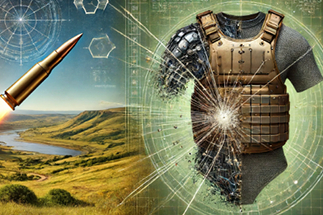14th Jun 2024
The Science Behind Body Armor Penetration: Understanding Protection and Vulnerabilities
When it comes to personal protection, body armor stands as one of the most vital tools for military personnel, law enforcement officers, and even civilians in high-risk areas. Understanding the science behind body armor penetration can shed light on how these protective gears work, their strengths, and their limitations.
What is Body Armor?
Body armor is designed to absorb and disperse the energy from a projectile, such as a bullet or shrapnel, preventing penetration into the body. Modern body armor typically falls into two categories: soft armor and hard armor.
- Soft Armor: Made from layers of woven or laminated fibers, soft armor is flexible and often used in everyday protective gear like bulletproof vests. Materials like Kevlar, Twaron, and ultra-high-molecular-weight polyethylene (UHMWPE) are commonly used.
- Hard Armor: Composed of rigid plates made from materials like steel, ceramic, or polyethylene, hard armor is used in higher threat environments. These plates are often inserted into tactical vests for added protection.
The Mechanics of Penetration
Penetration of body armor occurs when a projectile exceeds the material's ability to absorb and dissipate its energy. Several factors influence this process:
- Velocity and Mass of the Projectile: Higher velocity and heavier mass increase the kinetic energy of a projectile, making it more challenging to stop. Rifles, for example, fire bullets at much higher velocities than handguns, thus requiring stronger armor for protection.
- Shape of the Projectile: Bullets come in various shapes, including round-nose, hollow-point, and armor-piercing. Armor-piercing bullets are designed with hardened cores that concentrate force on a small area, enhancing their penetration capabilities.
- Angle of Impact: The angle at which a projectile strikes the armor affects penetration. A direct perpendicular hit delivers maximum force, while an oblique angle can cause the projectile to deflect, reducing its penetrative power.
Materials and Their Properties
- Kevlar and Twaron: These aramid fibers are lightweight and extremely strong. They work by "catching" the bullet in a web of fibers, distributing the force over a large area. This prevents penetration but can still cause blunt force trauma.
- UHMWPE: This material is lighter than Kevlar and has a higher tensile strength. It can stop bullets by dispersing the energy across its densely packed fibers.
- Ceramic Plates: Ceramic plates are very effective at stopping high-velocity rounds. When a bullet strikes, the ceramic shatters, dispersing the force and reducing the projectile's velocity. This destruction of the plate absorbs a significant portion of the bullet's energy.
- Steel Plates: Steel is durable and can stop multiple hits. However, it is heavier than other materials and can cause spalling, where fragments of the bullet and steel plate can become secondary projectiles.
Levels of Protection
Body armor is classified into different levels by organizations like the National Institute of Justice (NIJ). These levels indicate the types of threats the armor can withstand:
- Level II-A: Protection against 9mm and .40 S&W rounds.
- Level II: Improved protection against 9mm and .357 Magnum rounds.
- Level III-A: Protection against .357 SIG and .44 Magnum rounds.
- Level III: Protection against rifle rounds, such as 7.62mm FMJ.
- Level IV: Protection against armor-piercing rifle rounds.
The Role of Backface Deformation
Even if a bullet does not penetrate body armor, the force of impact can cause significant injury. This is known as backface deformation. Standards for body armor include limits on the amount of deformation allowed to reduce the risk of blunt force trauma. Advanced materials and design improvements aim to minimize this deformation, enhancing wearer safety.
Innovations and Future Directions
Advancements in materials science continually improve body armor effectiveness. Research into nanomaterials, such as graphene, promises even lighter and stronger protective gear. Additionally, integration of smart materials that can adapt their properties in response to threats is an emerging field.
Conclusion
Understanding the science behind body armor penetration reveals the complex interplay of materials, physics, and design that protects lives. While no armor can guarantee absolute safety, ongoing innovations continue to enhance the protective capabilities of body armor, offering greater security in an increasingly dangerous world.

